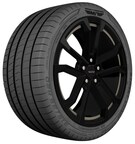AKRON, Ohio, February 24, 2010 – The Board of Directors of The Goodyear Tire & Rubber Company today announced that Richard J. Kramer was elected chief executive officer and president effective April 13, 2010, replacing Robert J. Keegan who will remain as executive chairman of the board. Kramer was also elected a member of the company’s board of directors.
“One of the keys to Bob Keegan’s success was his ability to attract and develop an impressive leadership team,” said James C. Boland, Goodyear’s lead director. “Through Bob’s mentoring of Rich Kramer over the past nine years, the close partnership that developed as they jointly created the company’s strategy, and with Rich’s successful performance in several critical leadership roles, this decision is the logical and anticipated culmination of a well thought out succession plan.”
“Mentoring and working side-by-side with Rich for more than nine years I’ve witnessed his strong professional growth whether it be his critical role in creating our strategy, his creation of a world class financial team as CFO, or his team building, leadership and motivational abilities in leading North American Tire through one of the most difficult periods in history,” Keegan said. “Rich brings to the table a deep knowledge of Goodyear, our global markets, manufacturing, finance and technology, which will lead Goodyear to the next level. Our company will be in good hands.”
Kramer, 46, who was named chief operating officer in June 2009, spent the previous three years successfully leading the company’s North American Tire business with a focus on customers and new product and process innovation. Prior to his North America assignment, he spent three years as executive vice president and chief financial officer. Kramer joined Goodyear as vice president of corporate finance in 2000. He was named senior vice president of strategy in 2003 where he began developing Goodyear’s strategy. Prior to joining Goodyear, Kramer spent 13 years with PricewaterhouseCoopers where he served in a variety of roles in the United States and Europe, ultimately as partner.
“Thanks to Bob’s leadership, our customers and the world see a new Goodyear – one that is more innovative, more agile, and more customer-focused than ever. We have the opportunity to build on that, particularly as the global economy begins to recover,” said Kramer. “I am honored that Bob and the board have the confidence in me to oversee one of the most recognizable and trusted brands in the world. At the same time I am excited about the opportunities the global tire industry is presenting us. Goodyear is well positioned to take advantage of those opportunities.”
Keegan, 62, joined Goodyear in 2000 as chief operating officer. He became president and chief executive officer in January 2003 and chairman of the board in July of that same year. Prior to Goodyear, Keegan was an executive vice president of the Eastman Kodak Company. Aside from a two-year stint as an executive vice president for the Avery Dennison Corporation, Keegan spent the bulk of his career from 1972 to 2000 serving in various financial, marketing and operating positions at Eastman Kodak.
“Bob’s tenure as CEO was one of the most extraordinary periods in Goodyear’s long and storied history,” Boland said. “Immediately upon assuming this role, he expertly guided the company through an historic turn-around involving a total transformation of the company, changing company strategy, operational execution and overall company culture. He emphasized outstanding leadership, innovation, performance and a strong focus on customers, and those traits continue to serve as pillars for the company during the recent global economic challenges.”
Important achievements and milestones during Keegan’s tenure at Goodyear included: transformational innovation across the operations, products and culture; a comprehensive capital structure improvement plan; an integration of two strong brands (Goodyear and Dunlop) in Europe; a refocus on new product development and marketing that resulted in both the highest-selling (Assurance) and fastest selling (FuelMax) tires in the company’s history; an aggressive and successful focus on high growth emerging markets; a groundbreaking establishment of the Voluntary Employees’ Beneficiary Association Trust (VEBA), which transferred control of North American retirees’ medical benefits to the United Steelworkers Union; and a renewed emphasis on investment in Goodyear’s core businesses.
“I can look back with pride at what our team at Goodyear has accomplished over the past seven years. It is a testament to our leadership team’s ability to design and successfully execute a game-changing business strategy, and to the dedication of Goodyear associates worldwide,” said Keegan. “I also can look forward with much optimism. Rich Kramer is a bright, experienced, energetic and charismatic leader who I believe very strongly is the right person to lead Goodyear into a future with considerable opportunities for growth.”
Goodyear is one of the world’s largest tire companies. It employs approximately 69,000 people and manufactures its products in more than 57 facilities in 23 countries around the world. Its two Innovation Centers in Akron, Ohio and Colmar-Berg, Luxembourg strive to develop state-of-the-art products and services that set the technology and performance standard for the industry. For more information about Goodyear, go to www.goodyear.com/corporate.
Certain information contained in this press release may constitute forward-looking statements for purposes of the safe harbor provisions of The Private Securities Litigation Reform Act of 1995. There are a variety of factors, many of which are beyond our control, that affect our operations, performance, business strategy and results and could cause our actual results and experience to differ materially from the assumptions, expectations and objectives expressed in any forward-looking statements. These factors include, but are not limited to: our ability to realize anticipated savings and operational benefits from our cost reduction initiatives or to implement successfully other strategic initiatives; increases in the prices paid for raw materials and energy; actions and initiatives taken by both current and potential competitors; deteriorating economic conditions or an inability to access capital markets; pension plan funding obligations; work stoppages, financial difficulties or supply disruptions at our suppliers or customers; a labor strike, work stoppage or other similar event; our failure to comply with a material covenant in our debt obligations; the adequacy of our capital expenditures; potential adverse consequences of litigation involving the company; as well as the effects of more general factors such as changes in general market, economic or political conditions or in legislation, regulation or public policy. Additional factors are discussed in our filings with the Securities and Exchange Commission, including our annual report on Form 10-K, quarterly reports on Form 10-Q and current reports on Form 8-K. In addition, any forward-looking statements represent our estimates only as of today and should not be relied upon as representing our estimates as of any subsequent date. While we may elect to update forward-looking statements at some point in the future, we specifically disclaim any obligation to do so, even if our estimates change.




